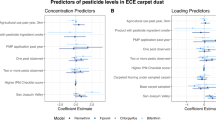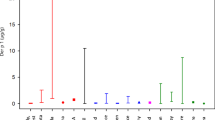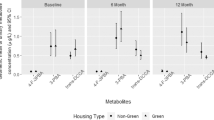Abstract
Epidemiologic studies have used both questionnaires and carpet dust sampling to assess residential exposure to pesticides. The consistency of the information provided by these two approaches has not been explored. In a population-based case–control study of non-Hodgkin's lymphoma, carpet dust samples were collected from the homes of 513 control subjects in Detroit, Iowa, Los Angeles, and Seattle. The samples were taken from used vacuum cleaner bags and analyzed for 30 pesticides. Interviewers queried subjects about the types of pests treated in their home using a detailed questionnaire accompanied by visual aids. Geographic variations in pesticide levels were generally consistent with geographic differences in pest treatment practices. Los Angeles residents reported the most treatment for crawling insects, fleas/ticks, and termites, and Los Angeles dust samples had the highest levels of propoxur, chlorpyrifos, diazinon, permethrin, and chlordane. Iowa had the most treatment for lawn/garden weeds, and also the highest levels of 2,4-dichlorophenoxyacetic acid and dicamba. Although Seattle had the highest proportion of subjects treating for lawn/garden insects, the lawn/garden insecticides were higher in other sites. Multivariate linear regression revealed several significant associations between the type of pest treated and dust levels of specific pesticides. The strongest associations were between termite treatment and chlordane, and flea/tick treatment and permethrin. Most of the significant associations were consistent with known uses of the pesticides; few expected associations were absent. The consistency between the questionnaire data and pesticide residues measured in dust lends credibility to both methods for assessing residential exposure to pesticides. The combined techniques appear promising for epidemiologic studies. Interviewing is the only way to assess pesticide exposures before current carpets were in place. Dust sampling provides an objective measure of specific compounds to which a person may have been exposed through personal use of a pesticide or by drift-in or track-in from outside, and avoids recall bias.
This is a preview of subscription content, access via your institution
Access options
Subscribe to this journal
Receive 6 print issues and online access
$259.00 per year
only $43.17 per issue
Buy this article
- Purchase on Springer Link
- Instant access to full article PDF
Prices may be subject to local taxes which are calculated during checkout
Similar content being viewed by others
References
Bradman M.A., Harnly M.E., Draper W., Seidel S., Teran S., Wakeham D., and Neutra R . Pesticide exposures to children from California's Central Valley: results of a pilot study. J Expo Anal Env Epidemol 1997: 7 (2): 217–234.
Camann D.E., Hsu, J.P., Fortmann R.C., Roberts J.W., and Lewis R.G . Association between measured pesticide levels in indoor air and carpet dust in the home. Presented May, 1991. In: Measurement of Toxic and Related Air Pollutants, Publication VIP-21, Air and Waste Management Association, Durham, NC. 1991: pp. 1113–1127.
Camann D.E . Investigating the effects of pesticide exposure in the home. Technol Today, June 1994: 2–7.
Colt J.S., Zahm S.H., Camann D.E., and Hartge P . Comparison of pesticides and other compounds in carpet dust samples collected from used vacuum cleaner bags and from the high volume surface sampler. Environ Health Perspect 1998: 106 (11): 721–724.
Efron B . Missing data, imputation, and the bootstrap. J Am Stat Assoc 1994: 89: 364–475.
Fortune D.R., Blanchard F.T., Ellenson W.D., and Lewis R.G . Analysis of aged in-home carpeting to determine the distribution of pesticide residues between dust, carpet, and pad compartments. EPA 600/R-00/030. 2000. http://www.epa.gov/ORD/WebPubs/carpet/600r00030.pdf.
Helsel D.R . Less than obvious — statistical treatment of data below the detection limit. Environ Sci Technol 1990: 24 (12): 1766–1774.
Kline & Company, Inc. Professional Markets for Pesticides and Fertilizers. Year Two: 1993. c.1994. Kline & Company, Inc., Little Falls, NJ, 1994.
Lewis R.G., Fortmann R.C., and Camann D.E . Evaluation of methods for monitoring the potential exposure of small children to pesticides in the residential environment. Arch Environ Contam Toxicol 1994: 26: 37–46.
Lewis R.G., Fortune C.R., Willis R.D., Camann D.E., and Antley J.T . Distribution of pesticides and polycyclic aromatic hydrocarbons in house dust as a function of particle size. Environ Health Perspec 1999: 107 (9): 721–726.
Lewis R.G., Fortune C.R., Blanchard F.T., and Camann D.E . Movement and deposition of two organophosphorous pesticides within a residence after interior and exterior applications. J Air Waste Manage Assoc 2001: 51: 339–351.
Lioy P.J., Edwards R.D., Freeman N., Gurunathan S., Pellizzari E., Adgate J.L., Quackenboss J., and Sexton K . House dust levels of selected insecticides and a herbicide measured by the EL and LWW samplers and comparisons to hand rinses and urine metabolites. J Expo Anal Environ Epidemiol 2000: 10: 327–340.
Moschandreas D.J., Karuchit S., Kim Y., Ari H., Lebowitz M.D., O'Rourke M.K., Gordon S., and Robertson G . On predicting multi-route and multimedia residential exposure to chlorpyrifos and diazinon. J Expo Anal Environ Epidemiol 2001: 11 (1): 56–65.
Nigg N.H., Beier R.C., Carter O., Chaisson C., Franklin C., Lavy T., Lewis R.G., Lombardo P., McCarthy J.F., and Maddy K.T . Exposure to pesticides. In: Mehlman M.A. (Ed.). Advances in Modern Environmental Toxicology, Vol XVIII: The Effects of Pesticides on Human Health (Baker SR, Wilkinson CF, Eds.). Princeton, NJ: Princeton Scientific, 1990: pp. 35–130.
Pang Y., MacIntosh D.L., Camann D.E., and Ryan P.B . Analysis of aggregate exposure to chloryprifos in the NHEXAS-Maryland Investigation. Environ Health Perspec 2002: 110 (3): 235–240.
Roberts J.W., Budd W.T., Camann D.E., Fortmann R.D., Lewis R.G., Ruby M.G., and Spittler T.M . Human exposure to pollutants in the floor dust of homes and offices. J Expo Anal Environ Epidemiol 1992: 2 (Suppl. 1): 127–146.
Roinestad K.S., Louis J.B., and Rosen J.D . Determination of pesticides in indoor air and dust. J Assoc Off Anal Chem Intl 1993: 76: 1121–1126.
Rubin D.B . Multiple Imputation for Nonresponse in Surveys. John Wiley & Sons, New York, 1987.
Sexton K., Adgate J.L., Elberly L.E., Clayton C.A., Whitmore R.W., Pellizzari E.D., Lioy P.J., and Quackenboss J.J . Predicting children's short-term exposure to pesticides: results of a questionnaire screening approach. Environ Health Perspect 2003: 111 (1): 123–128.
Simcox J.J., Fenske R.A., Wolz S.A., Lee I.C., and Kalman D . Pesticides in household dust and soil: exposure pathways for children of agricultural families. Environ Health Perspect 1995: 103: 1126–1134.
Starr H.G., Aldrich F.D., McDougall W.D., and Mounce L.M . Contribution of household dust to the human exposure to pesticides. Pesticides Monit J 1974: 8: 209–212.
Whitmore R.W., Immerman F.W., Camann D.E., Bond A.E., Lewis R.G., and Schaum J.L . Non-occupational exposures to pesticides for residents of two U.S. cities. Arch Environ Contam Toxicol 1994: 26: 47–59.
Whitmore R.W., Kelly J.E., and Reading P.L . National home and garden use survey, final report, Volume I: Executive summary, results, and recommendations. Prepared by Research Triangle Institute for the US. Environmental Protection Agency under Contract No. 68-WO-0032. Research Triangle Park, NC, 1992.
Zahm S.H., Ward M.H., and Blair A . Pesticides and cancer. Occup Med: State of the Art Rev 1997: 12 (2): 269–289.
Author information
Authors and Affiliations
Corresponding author
Appendix A. Imputation of missing data
Appendix A. Imputation of missing data
Imputation procedures were used to fill in “missing” pesticide concentrations, which occurred when the analyte concentration was below the analytic detection limit of the GC/MS, or the presence of interfering compounds in the dust sample made it difficult for the GC/MS analyst to determine whether the target analyte was present and, if so, at what level. In this study, detection limits for individual analytes varied across samples. After about half of the samples had been analyzed, we began monitoring additional ions for some neutral analytes to clarify their identification at low levels; this resulted in raised detection limits for 14 pesticides. Deviations in detection limits also occurred when less than 2 g of dust was available.
When an interfering compound was present in the dust sample, the GC/MS analyst made a judgment as to whether the target compound was also present. If he/she judged that an interfering compound and the target analyte were both present, the result was reported as an “elevated detection” at a concentration equal to the entire peak of the coeluting compounds. If the analyst had insufficient evidence that the target analyte was present, the result was reported as a nondetect with a detection limit equal to the entire peak. In both cases, the result was flagged to indicate that the concentration or detection limit had been raised to account for the uncertainty posed by the presence of an interfering compound.
To account for the missing data, we first set a lower and upper bound for each missing data point based on information reported by the GC/MS analyst. If the result was a nondetect and no interferences were present, we set the lower bound at zero and the upper bound at the detection limit reported for that sample. If the result was a nondetect with a raised detection limit due an interfering compound, we bounded the concentrations between zero and 20% of the raised detection limit. If the result was an “elevated detection” because of an interference, we set the bounds at 20% and 90% of the reported concentration.
We then assigned a value for each missing measurement by selecting a value from the assumed distribution using maximum likelihood parameter estimates. We created a likelihood function as the product of the normal density function at the log-transformed value for the known measurements and the cumulative normal distribution function at the log-transformed bounds for the missing measurements. We then determined the maximum likelihood estimates of μ and σ, denoted μ̂ and ς̂, respectively. We imputed a value for each missing measurement by randomly sampling from a log-normal distribution with parameters μ̂ and ς̂, conditional on being bounded by the values discussed above. To account for uncertainty in the estimation of parameters, we did not use μ̂ and ς̂ for the imputation, but instead used μ̂* and ς̂*, which were selected from a bootstrap sample of 500 realizations of μ̂ and ς̂ (Efron, 1994). The bootstrap sample was generated by estimating μ̂ and ς̂ from 500 data sets created by repeatedly sampling with replacement from the original data set to create 500 data sets of equal size. There is an additional source of variation which was not taken into account in this approach, since we implicitly assume that the bounds were fixed. For the cases of interfering compounds, this assumption cannot be justified. However, we believe that this additional random variation is not likely to affect inference.
Rights and permissions
About this article
Cite this article
Colt, J., Lubin, J., Camann, D. et al. Comparison of pesticide levels in carpet dust and self-reported pest treatment practices in four US sites. J Expo Sci Environ Epidemiol 14, 74–83 (2004). https://doi.org/10.1038/sj.jea.7500307
Received:
Accepted:
Published:
Issue Date:
DOI: https://doi.org/10.1038/sj.jea.7500307
Keywords
This article is cited by
-
Impacts of dietary exposure to pesticides on faecal microbiome metabolism in adult twins
Environmental Health (2022)
-
Recent progress in the chemical attribution of chemical warfare agents and highly toxic organophosphorus pesticides
Forensic Toxicology (2021)
-
Persistence of indoor permethrin and estimation of dermal and non-dietary exposure
Journal of Exposure Science & Environmental Epidemiology (2020)
-
Agricultural and domestic pesticides in house dust from different agricultural areas in France
Environmental Science and Pollution Research (2019)
-
An algorithm for quantitatively estimating non-occupational pesticide exposure intensity for spouses in the Agricultural Health Study
Journal of Exposure Science & Environmental Epidemiology (2019)



